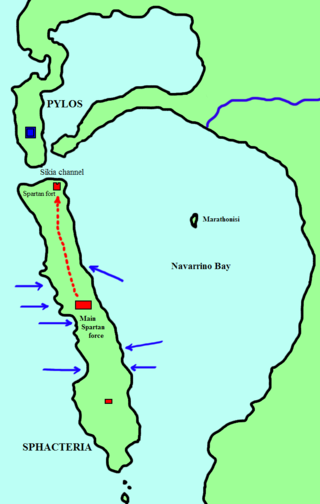
The Peloponnesian War was an ancient Greek war fought between Athens and Sparta and their respective allies for the hegemony of the Greek world. The war remained undecided until the later intervention of the Persian Empire in support of Sparta. Led by Lysander, the Spartan fleet finally defeated Athens which began a period of Spartan hegemony over Greece.

The 5th century BC started the first day of 500 BC and ended the last day of 401 BC.
This article concerns the period 429 BC – 420 BC.
This decade witnessed the continuing decline of the Achaemenid Empire, fierce warfare amongst the Greek city-states during the Peloponnesian War, the ongoing Warring States period in Zhou dynasty China, and the closing years of the Olmec civilization in modern-day Mexico.

Acarnania is a region of west-central Greece that lies along the Ionian Sea, west of Aetolia, with the Achelous River for a boundary, and north of the gulf of Calydon, which is the entrance to the Gulf of Corinth. Today it forms the western part of the regional unit of Aetolia-Acarnania. The capital and principal city in ancient times was Stratos. The north side of Acarnania of the Corinthian Gulf was considered part of the region of Epirus.
Year 413 BC was a year of the pre-Julian Roman calendar. At the time, it was known as the Year of the Consulship of Cossus and Medullinus. The denomination 413 BC for this year has been used since the early medieval period, when the Anno Domini calendar era became the prevalent method in Europe for naming years.

Year 414 BC was a year of the pre-Julian Roman calendar. At the time, it was known as the Year of the Tribunate of Cossus, Ambustus, Potitus and Albinus. The denomination 414 BC for this year has been used since the early medieval period, when the Anno Domini calendar era became the prevalent method in Europe for naming years.
Year 424 BC was a year of the pre-Julian Roman calendar. At the time, it was known as the Year of the Tribunate of Crassus, Fidenas, Rutilus and Iullus. The denomination 424 BC for this year has been used since the early medieval period when the Anno Domini calendar era became the prevalent method in Europe for naming years.
Year 425 BC was a year of the pre-Julian Roman calendar. At the time, it was known as the Year of the Tribunate of Atratinus, Medullinus, Cincinnatus and Barbatus. The denomination 425 BC for this year has been used since the early medieval period, when the Anno Domini calendar era became the prevalent method in Europe for naming years.

The Peace of Nicias was a peace treaty signed between the Greek city-states of Athens and Sparta in March 421 BC that ended the first half of the Peloponnesian War.

Nicias was an Athenian politician and general during the period of the Peloponnesian War. Nicias was a member of the Athenian aristocracy and had inherited a large fortune from his father, which was invested in the silver mines around Attica's Mt. Laurium. Following the death of Pericles in 429 BC, he became the principal rival of Cleon and the democrats in the struggle for the political leadership of the Athenian state. He was a moderate in his political views and opposed the aggressive imperialism of the democrats. His principal aim was to conclude a peace with Sparta as soon as it could be obtained on terms favourable to Athens.

The Sicilian Expedition was an Athenian military expedition to Sicily, which took place from 415–413 BC during the Peloponnesian War between Athens on one side and Sparta, Syracuse and Corinth on the other. The expedition ended in a devastating defeat for the Athenian forces, severely impacting Athens.
The Battle of Olpae took place during the Peloponnesian War in 426 BC, between armies led by Athens and Sparta.

The Battle of Sphacteria was a land battle of the Peloponnesian War, fought in 425 BC between Athens and Sparta. Following the Battle of Pylos and subsequent peace negotiations, which failed, a number of Spartans were stranded on the island of Sphacteria. An Athenian force under Cleon and Demosthenes attacked and forced them to surrender.

Demosthenes, son of Alcisthenes, was an Athenian general during the Peloponnesian War.
Laches was an Athenian aristocrat and general during the Peloponnesian War.
The Battle of Idomene took place during the Peloponnesian War in 426 BC, between the Athenians and the Ambracians.
The Aetolian campaign, often referred to as "Demosthenes' Aetolian campaign", was a failed Athenian offensive in northwestern Greece during the Archidamian War. In 426 BCE, Demosthenes was dispatched from Athens to the Corinthian Gulf in command of a fleet of 30 ships. Arriving in the north-west, he quickly assembled a coalition force from Athens' allies in the region and besieged the city of Leucas. However, before the siege reached a conclusion, he was persuaded to abandon it in favour of an attack on the tribal region of Aetolia. Leaving Leucas, he set out towards Aetolia, losing along the way several major contingents from his army, whose leaders were apparently unhappy with his change in strategy.
Olpae or Olpai was a town of ancient Amphilochia, where the Battle of Olpae was fought between the Spartans and the Athenians in 426 BC during the Peloponnesian War. Olpae sat upon a fortified hill, in the territory of Amphilochian Argos, 25 stadia from Argos itself. Eurylochus, the Spartan commander, marched from Aetolia, with 3000 hoplites into the territory of Amphilochian Argos, and captured Olpae.
Amphilochian Argos was the chief town of ancient Amphilochia, situated at the eastern extremity of the Ambraciot Gulf, on the river Inachus. Its territory was called Argeia (Ἀργεία).








